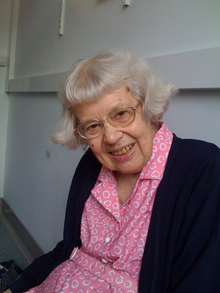Mary F. Lyon
| Mary F. Lyon | |
|---|---|
 |
|
| Born | Mary Frances Lyon 15 May 1925 Norwich, England |
| Died | 25 December 2014 (aged 89) |
| Alma mater | University of Cambridge (BA, PhD) |
| Doctoral advisor | Ronald Fisher |
| Doctoral students | Sohaila Rastan, Elizabeth Fisher (co-supervised with Steve Brown) |
| Known for | X-chromosome inactivation |
| Notable awards |
|
Mary Frances Lyon FRS (15 May 1925 – 25 December 2014) was an English geneticist, who is best known for her discovery of X-chromosome inactivation, an important biological phenomenon.
Mary Lyon was born on 15 May 1925 in Norwich, England as the eldest out of three children of a civil servant and a schoolteacher. She was educated at a grammar school in Birmingham. During that time, she said, she became interested in science thanks to a good schoolteacher and nature books she won in an essay competition. During the second world war, she pursued her studies at Girton College, Cambridge at the University of Cambridge, where she read zoology, physiology, organic chemistry and biochemistry, with zoology as her main subject. At this time, only 500 female students were allowed to study at the university, in contrast to more than 5,000 men. Furthermore, the woman received only a “titular” degree, simply put, she wasn't awarded a degree, despite attending the lectures with men, taking the same practical courses and passing the same exams as the men. During that time she became interested in embryology. She went on to do her PhD with R A Fisher, who was Professor of Genetics in Cambridge, where she characterized a mutant mice strain with a 'pallid' mutation and published the research. During the course of her PhD she moved to Edinburgh.
After her PhD Mary Lyon joined the group of Conrad Hal Waddington, with whom she worked in the last part of her PhD. The group was funded by the Medical Research Council to investigate mutagenesis and the genetic risks of radiation. In addition to the 'pallid' mutation mice, she studied mutations such as 'ataxia' (a nervous mutation which caused walking difficulties in the mice) and 'twirler' (a mutation which induced inner ear issues, causing the mice to shake their heads and walk in circles due to lack of balance).
In 1955, her group moved to the MRC radiobiology unit in Harwell, where there was room for more mouse facilities. There she continued to investigate the mouse mutations. She also scrutinized a 'mottled' mutant, which had a different effect on male and female mice: male embryos sometimes died, and the surviving males had white coats, but females lived and were variegated. Through calculated and deliberated breeding of mutants, she investigated the transition of the mutation and concluded that the mutation was positioned on the X chromosome. This, together with new findings at that time concerning the X chromosome, led her to hypothesize about X chromosome silencing.
...
Wikipedia
